
Dordura is a monotypic moth genus of the family Noctuidae erected by Frederic Moore in 1882. Its only species, Dordura aliena, was first described by Francis Walker in 1865. It is found in the Indian subregion, Sri Lanka, Myanmar, Thailand, Peninsular Malaysia, Sumatra, Borneo and New Guinea.

Psimada is a monotypic moth genus of the family Noctuidae. Its only species, Psimada quadripennis, is found in the Indian subregion, southern China, Taiwan, Myanmar, Thailand, Sri Lanka, the Andaman Islands, Sundaland, Sulawesi and Seram. Both the genus and species were first described by Francis Walker in 1858.
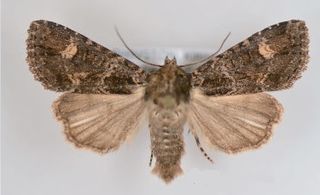
Aseptis binotata, the rusty shoulder knot moth, is a moth of the family Noctuidae. The species was first described by Francis Walker in 1865. It is found widespread in western North America, west of south-central Alberta, Wyoming, and Nebraska. Along the Pacific Coast it occurs from northern Mexico to south-central British Columbia. It can be found from sea level to altitudes over 2000 meters in a variety of habitats from dense forest to shrub desert.
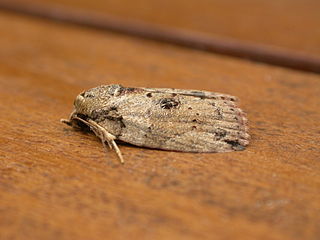
Nanaguna breviuscula, the pigeonpea pod borer, is a moth species of the family Nolidae. It is found from Sri Lanka and India east to Samoa. In Australia it is found in the Kimberleys in Western Australia, the northern part of the Northern Territory and from the Torres Strait Islands and Queensland to Sydney in New South Wales.

Philonome is a genus of moths in the family Tineidae.

Ischyja manlia is a species of moth of the family Noctuidae first described by Pieter Cramer in 1776. It is found in the Indian subregion, Sri Lanka, Myanmar, Thailand, China, Okinawa, Sundaland, Sulawesi, Korea, the southern Moluccas, Australia (Queensland) and Palau. Adults pierce the skin of fruit to suck the juice.
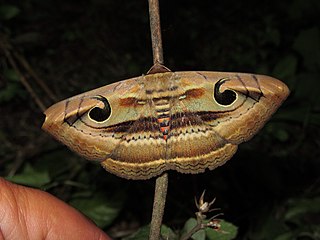
Spirama retorta, the Indian owlet-moth, is a moth of the family Erebidae. The species was first described by Carl Alexander Clerck in 1764. It is found in China, Korea, Japan (Honshu), India, Nepal, Bangladesh, Thailand, Cambodia, Myanmar, Vietnam, Taiwan, Sri Lanka, Malaysia, the Philippines (Luzon), Indonesia ,Japan.

Westermannia superba is a moth of the family Nolidae first described by Jacob Hübner in 1823. It is found on New Guinea, Australia (Queensland), India, Sri Lanka, Singapore and on Sumatra, Borneo and Palawan.

Ichneutica oliveri is a moth of the family Noctuidae. It is endemic to New Zealand, found only in the South Island. However it has not been observed on the eastern side of that island from mid-Canterbury southwards to Southland. This species is distinctive and is unlikely to be confused with other closely related species. It inhabits tussock grasslands, shrubland as well as granite sand plains, all in the alpine zone. Adults are on the wing from December to March and are attracted to light. They have been observed feeding on the flowers of Hebe species. The life history of this species is unknown as are the larval hosts.

Leucinodes malawiensis is a species of moth in the family Crambidae. It is found in Malawi. The species was described by Richard Mally, Anastasia Korycinska, David J. L. Agassiz, Jayne Hall, Jennifer Hodgetts and Matthias Nuss in 2015.
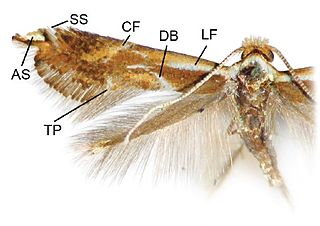
Philonome cuprescens is a species of moth of the family Tineidae. It is found in Mexico (Guerrero).

Philonome wielgusi is a species of moth of the family Tineidae. It is found in the south-western United States, where it has been recorded from Arizona.

Philonome nigrescens is a species of moth of the family Tineidae. It is found in the south-western United States, where it has been recorded from Arizona and New Mexico.

Philonome lambdagrapha is a species of moth of the family Tineidae. It is found in French Guiana.

Philonome curvilineata is a species of moth of the family Tineidae. It is found in French Guiana.

Philonome albivittata is a species of moth from the Tineidae family found in French Guiana.
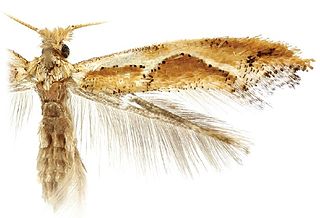
Philonome kawakitai is a species of moth of the family Tineidae first described by Jae-Cheon Sohn, Donald Davis and Carlos Lopez-Vaamonde in 2015. It is found in French Guiana.

Philonome rivifera is a species of moth of the family Tineidae. It is found in Guyana.

Philonome spectata is a species of moth of the family Tineidae. It is found in Brazil (Pará).

Macronoctua onusta, commonly known as the iris borer, is a species of cutworm or dart moth in the family Noctuidae. It is found in North America.





















